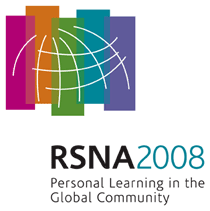
Abstract Archives of the RSNA, 2008
LL-GI4314-R08
Metastatic Nodal Status of Esophageal Cancer in DWI Findings in Comparison with PET: True Positive versus False Negative
Scientific Posters
Presented on December 4, 2008
Presented as part of LL-GI-R: Gastrointestinal
Kiyohiko Shuto MD, PhD, Presenter: Nothing to Disclose
Gaku Ohira, Abstract Co-Author: Nothing to Disclose
Tomoyoshi Aoyagi MD, Abstract Co-Author: Nothing to Disclose
Kazuo Narushima MD, PhD, Abstract Co-Author: Nothing to Disclose
Asami Sato, Abstract Co-Author: Nothing to Disclose
Hisahiro Matsubara MD, PhD, Abstract Co-Author: Nothing to Disclose
Hiroshige Saito MD, Abstract Co-Author: Nothing to Disclose
Takumi Ota MD, Abstract Co-Author: Nothing to Disclose
et al, Abstract Co-Author: Nothing to Disclose
To evaluate metastatic lymph nodes (LN) of esophageal squamous cell cancer (SCC) and to assess the difference between true positive (TP) nodes and false negative (FN) using by diffusion-weighted magnetic resonance imaging (DWI) comparing with FDG PET.
Forty consecutive patients of esophageal SCC were enrolled. All of the patients underwent radical esophagectomy with cervico-thoraco-abdominal lymphadenectomy. MR images were acquired using a 1.5T scanner with following parameters: T2-weighted, fast spin-echo sequence, TR/TE 3300/90 ms; DWI, single shot spin-echo type of echo planar sequence, TR/TE 10000/75 ms. The corresponding b-value to the diffusion sensitizing gradients were b=0, 1000 s/mm2. PET imaging was performed using 370 MBq of F18-DG tracer. Definition as metastasis was made by using T2-WI/DWI fused image measuring apparent diffusion coefficient (ADC) value and was made as SUV > 3 on PET images. Dissected LNs were divided into regional LN groups. In histological positive nodes we compared both imaging with nodal size and percent area of cancer nest, and assessed the difference between TP and FN. If two or more metastatic nodes exist in one LN group, the maximum value was used for evaluation.
561 lymph node groups were examined. Forty-seven (8%) were proven positive for metastasis (mean size, 8.3mm and mean percent area of cancer nest, 43%). The sensitivity of DWI and PET were 73% and 53% with significantly difference (P=0.030). The combination of DWI and PET yielded a better sensitivity (81%). No significantly difference between TP and FN was observed in nodal size in both imaging (DWI; 9.0mm vs. 7.5, P=0.105, PET; 8.9 vs. 7.6, P=0.593, respectively). There was a significantly difference in percent area of cancer nest in DWI (TP vs. FN = 52% vs. 17%, P=0.021), however no difference was seen in PET (TP vs. FN = 44% vs. 43%, P=0.837).
Noninvasive DWI yielded a better predictive power than PET and may be one of the valid and the initial modalities to predict nodal metastasis of esophageal cancer. However it was supposed to be affected by the density of cancer cells rather than PET, and could detect LNs if cancer cells occupy approximately 50% of a node.
When N staging is discussed, the nodal status of cancer cell density is not always estimated. This may be an informative research assessing detectable metastatic LNs and cancer density using by DWI.
Shuto, K,
Ohira, G,
Aoyagi, T,
Narushima, K,
Sato, A,
Matsubara, H,
Saito, H,
Ota, T,
et al, ,
Metastatic Nodal Status of Esophageal Cancer in DWI Findings in Comparison with PET: True Positive versus False Negative. Radiological Society of North America 2008 Scientific Assembly and Annual Meeting, February 18 - February 20, 2008 ,Chicago IL.
http://archive.rsna.org/2008/6008073.html

